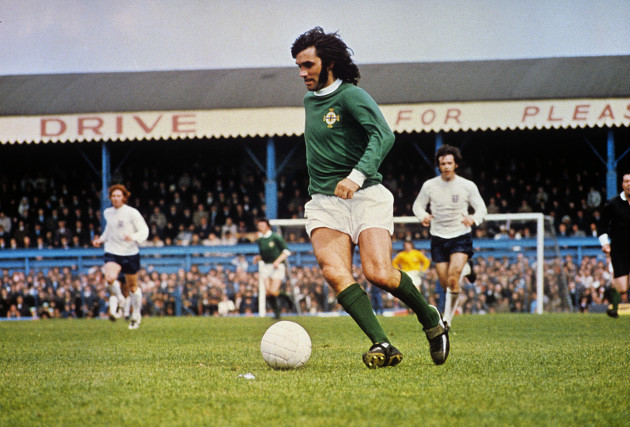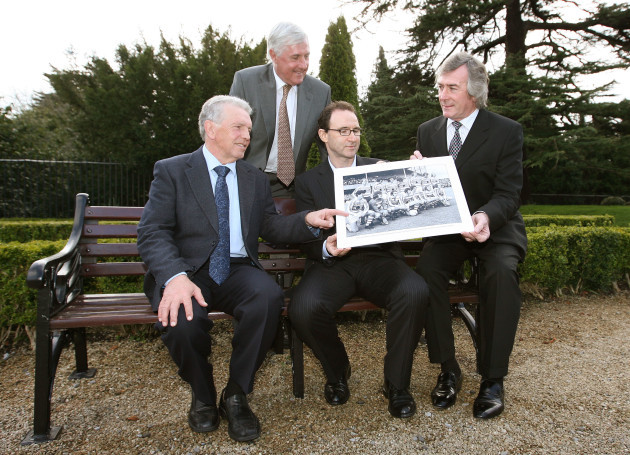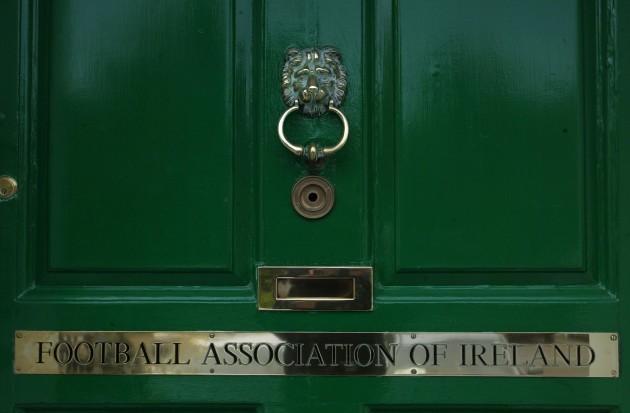THE ANIMOSITY BETWEEN the Football Association of Ireland (FAI) and the Irish Football Association (IFA) that had coloured the whole of the 1950s gave way to a more conciliatory approach adopted by both associations in the 1960s.
IFA representatives were in attendance at an international match between the Republic of Ireland and Poland in 1964. It did lead to protests in the North, as the match was held on a Sunday, with some commenting on the hypocrisy of suspending amateur players who played on Sundays whilst officials were allowed to attend matches on the Sabbath day.
It was agreed in 1965 to inaugurate an annual fixture between youth teams from the North and the South and in 1967 the Blaxnit All-Ireland cup competition was launched with four teams representing the FAI and four teams the IFA.
Despite these advances and the calls from illustrious players, such as George Best, enthusiastically supporting an all-Ireland international team, it was still believed unification was far off due to the ‘internal politics of Irish soccer’.
A motion was defeated at a council meeting of the FAI in 1969 to approach the IFA with a view to the establishment of an all-Ireland soccer team.
The escalating violence in the North of Ireland from the late 1960s appeared to scupper any chances of healing the split in Irish soccer, with the Blaxnit Cup considered to be in jeopardy as a viable entity in early 1970 due to the Troubles. A boost was received later in the year, though, when a team composed of Republic of Ireland and Northern Ireland players was selected to play against Arsenal in a benefit match for Terry Neill.
It was also reported that the FIFA president, Stanley Rous, ‘would welcome any move to fuse the Football Association of Ireland and the Irish Football Association’ and that IFA secretary, William Drennan ‘agreed that both Irish bodies should be working towards an all-Ireland side.’
In the build up to the Terry Neill benefit match, George Best reiterated his call for an all-Ireland international team, claiming he had ‘talked to several players from the South and they all want to see a full Irish team. I know the Northern Ireland players think the same way.’
With administrators from both associations more open to reconciliation, the fans and the new political realities of Northern Ireland would intervene to maintain the chasm. At the Blaxnit Cup Final of 1971 between Linfield and Cork Hibernians, held in Dalymount Park, crowd trouble coloured the match. The Linfield supporters waved Union Jacks whilst shouting ‘Up the UVF’ leading to both sections of supporters throwing bottles and stones at each other.
The rioting continued after the match. The nationalist-leaning club Derry City was dealt a significant blow when its ground, the Brandywell, close to the Bogside in Derry, scene of many riots, was considered too dangerous to host games and the club was forced to play its ‘home’ games in Coleraine, forty miles from the city.
Harry Cavan, the IFA president, had previously claimed to the press that it was too unsafe to hold European Cup matches at the Brandywell. The club decided to withdraw from Irish league football in 1972, following in the footsteps of its predecessor, Belfast Celtic.
The FAI commissioned a report on association football which was published in May 1973, on the ills that beset the game in the country. It was chaired by Fianna Fáil TD, David Andrews. On the prospect of reunification, the report stated ‘that in the long term a country-wide league competition, including teams from Northern Ireland, be considered’.
One event that happened just months later offered encouragement to those who dreamed of an all-Ireland team. Such a team comprising players from Northern Ireland and the Republic of Ireland did play together in July 1973 as a ‘Shamrock Rovers All-Ireland XI’ against Brazil, a team considered the greatest of all time, having won its third World Cup three years previously.
The game, which ended four-three to the Brazilians was enthusiastically supported by 34,000 attendees at Lansdowne Road in Dublin, who heard a rendition of ‘A Nation Once Again’ by the St Patrick’s Brass and Reed Band beforehand. Many observers believed the event would lead to ‘an all-Ireland team in action in world competition’ in the not too distant future.
The FAI subsequently sent the IFA a letter requesting a meeting ‘to discuss matters of mutual interest’, a meeting the IFA unanimously agreed to attend.19 At that conference, held in Belfast on 2 October, ‘a very lengthy and amicable discussion’ was held, in stark contrast to many of the failed attempts between both associations in years past.
Four main topics were discussed at the meeting: the effect and correctness of ‘scratch teams’; the possibility of all-Ireland competitions with European ramifications; the possibility of an all-Ireland international team either under the jurisdiction of a joint committee or under the jurisdiction of one association and closer liaison on matters of mutual co-operation such as organising joint competitions like the Blaxnit and Texaco tournaments; and education around coaching courses, referees’ courses and school football.
At the conclusion of the meeting it was agreed that ‘further joint meetings of office bearers be arranged.’
The next meeting between the associations took place in Dublin in January 1974. Both agreed that ‘scratch teams’ should not be permitted to play matches. On the issue of an all-Ireland league competition, it was felt this venture would not be possible without ‘very substantial sponsorship’.
On the primary issue of the possibility of an all-Ireland team, Harry Cavan ‘pointed out that both Associations at present have the right of entry to the World Cup Competition and the European Football Championship. If there was an All Ireland team, there could only be one entry to both these Competitions.’
It was suggested by the FAI that there was the possibility of the Irish FA calling on Southern born players for the British International Championship and the FA of Ireland calling on Northern Ireland born players for friendly matches arranged by the FA of Ireland. After further consideration it was agreed that the Irish FA would ascertain the views of the other British Associations . . . and Mr. Cavan would also enquire from FIFA about their reaction to such an arrangement.
No deal
No agreement was reached, and talks were still in progress some months later. In deploring the failure of the Scottish Football Association to send its international team to Belfast, the Northern Ireland Minister for Community Relations, Ivan Cooper, commented that discussions were ongoing between the FAI and IFA ‘with a view to the possible creation of an all-Ireland soccer team.’26 By 1974, no international team had played in Northern Ireland, due to the Troubles, for three years; the last team to visit was the Soviet Union in 1971.
The Northern Ireland soccer team ultimately played 10 ‘home’ games in Britain from 1972 to 1978 due to civil unrest. The talks of 1973–74 ultimately failed on the question of the IFA looking for the FAI to amalgamate back into the IFA, something the southern body was unwilling to do.
The IFA agreed to meet after another request was made by the FAI in 1977 ‘to discuss the possibility of an All Ireland International team.
Cavan, who was also a vice-president of FIFA, said ‘he saw no reason why there should not be further discussions on the matter’ even if ‘there were “practical difficulties”’ involved. He also mentioned that ‘there might be some difficulty in convincing FIFA of the feasibility of fielding just one national team, representative of two different associations, for competitive games such as the World Cup and European Championship ties.
Commenting on the renewal of talks, David Andrews, who had become Parliamentary Secretary (Minister of State) to the Minister for Foreign Affairs earlier in the year, believed it was ‘one of the most encouraging and significant developments on the Irish soccer front in recent years’. He was in favour of a federation of Irish football where a team chosen from both associations would ‘play two international friendly matches every year against the top teams in Europe.’
Coinciding with the renewal of talks, was the pairing of Northern Ireland with the Republic of Ireland in Group One of the 1980 European Championship qualifiers in late 1977.
England was also drawn in the same group. Considered by The Irish Times to be ‘a nice touch of irony at a time when moves are afoot to explore the possibility of fielding just one international soccer team’, it would lead to the first clash between the teams at senior international level. The first concern that came to most people’s minds was the security concerns the clashes in Dublin and Belfast would pose due to the violence that had engulfed Northern Ireland over the previous eight years.
One commentator called it ‘the worst thing that could possibly happen to soccer football in this country’ adding that it could ‘set the scene for the most serious football riots of all time since a war broke out over the result of a match in South America (the ‘Football War’ of 1969 between Honduras and El Salvador).’36
It was envisaged the talks would be ongoing over months, perhaps years, to reach an agreement satisfactory to both the IFA and FAI. The most likely solution, it was believed, was an ‘all-Ireland Control body which, while guaranteeing the sovereignty of the two associations, will enable them to co-operate for the purpose of promoting international football.
New push
The first session of the ‘newest, and clearly, the most determined campaign so far, to attain the long-cherished goal of an all-Ireland team in international football’ took place in Dundalk on 2 February 1978.
Frank Davis, the FAI president, was very upbeat after the first session, stating, ‘With the goodwill shown around the table today, I believe that, whatever the timing, an all-Ireland team must now come into being… The fact that we are drawn together in the European championship is another means of bringing us closer and getting to know each other’s options.’
Commenting on the unity talks between the two Irish associations, the Kerryman compared the divide in Irish soccer to hockey in Ireland, where a thirty-two county team was due to compete in the men’s World Cup Hockey Finals in Argentina that summer.
The soccer World Cup Finals were also due to be played in Argentina in 1978. Neither Irish team qualified for the soccer World Cup. The Hockey Association was involved in a controversial episode with the GAA, who disallowed four of its members from participating in a fund-raising function for the Irish hockey team as the latter ‘uses “Danny Boy” instead of “Amhrán na bhFiann” as an anthem, and substitutes the flag of the Four Provinces for the Tricolour as a national flag.’
The paper claimed an all-Ireland soccer team would be going to Argentina too and if the price of that unity was ‘Danny Boy’ and a flag of the Four Provinces, it was a price worth paying.
The second session held a month later in Dublin was also considered a positive meeting with the discussions ‘taking place in a friendly, cordial atmosphere and that some progress had been made.’ Security arrangements were discussed for the upcoming clashes between both Irish associations with the consensus being that the matches posed ‘no insurmountable problems’.
The meeting concluded with the arrangement for a third meeting in Belfast a month later. At the IFA AGM of 1979, Harry Cavan, ‘the man whom many people in the Republic thought was the principal opponent of the move’ for an all-Ireland team, claimed ‘that two teams in a small country like this was nonsensical, but he warned that anyone who thought that a united Ireland team would win the World Cup was living in cuckoo land.’
The meetings stuttered along at a torturous pace over the following years.
The main stumbling blocks appeared not to be on the sensitive issues of flag and anthem but on money and the financial dilemma the halving of revenue from international fixtures would cause. It was still agreed to meet again in January 1980, grounds for optimism according to Peadar O’Driscoll, FAI secretary, who claimed, ‘the longer the talks progress, the better the chances of a solution.’
The following round of talks, held in Dublin in January 1980, would prove to be a turning point, though, bringing the venture that had started in earnest in 1973 ‘close to total breakdown’. The primary reason for the pessimism was the ongoing conflict in Northern Ireland, manifested during the Linfield-Dundalk riot the previous year. Cavan commented on the major problem of community feeling in the North.
I went on record a few years ago as saying that something positive in the All Ireland context would be achieved by the IFA’s centenary year, which is this year. I didn’t realise at the time that the community unrest would still be such a huge problem in 1980.
The problem of reconciling the concept of an all-Ireland team with the rules of FIFA was also mentioned as an obstacle, with FIFA rules prohibiting the formation of one team for competitive purposes where a political border exists between two countries.
Despite attempts by the FAI to renew talks in 1981, the divides were ‘still so great, the difficulties so complex and the avenues of finding a solution so long’, for any more meaningful attempt to be made at union.
Derek Brookes, secretary of Linfield, summed up the main obstacle to unity:
The problem with people who speak glibly of unity in Irish soccer . . . is that they tend to ignore the facts of life here in the North of Ireland. The concept of one Ireland football team may be exciting but, unfortunately, it does not take account of the fact that we are living in troubled times. People must live six days a week in that environment. It is unreasonable to expect that football can be immune on the seventh.
The political factor was eventually acknowledged by the FAI as the primary hindrance to overcome. Its president, John Farrell, stated in 1983, ‘there will be no settlement of the split in Irish soccer until such time as the political problems which divide the
North and the Republic have been solved.
This is an edited extract from Cormac Moore’s ‘The Irish Soccer Split’ which is published by Atrium.



